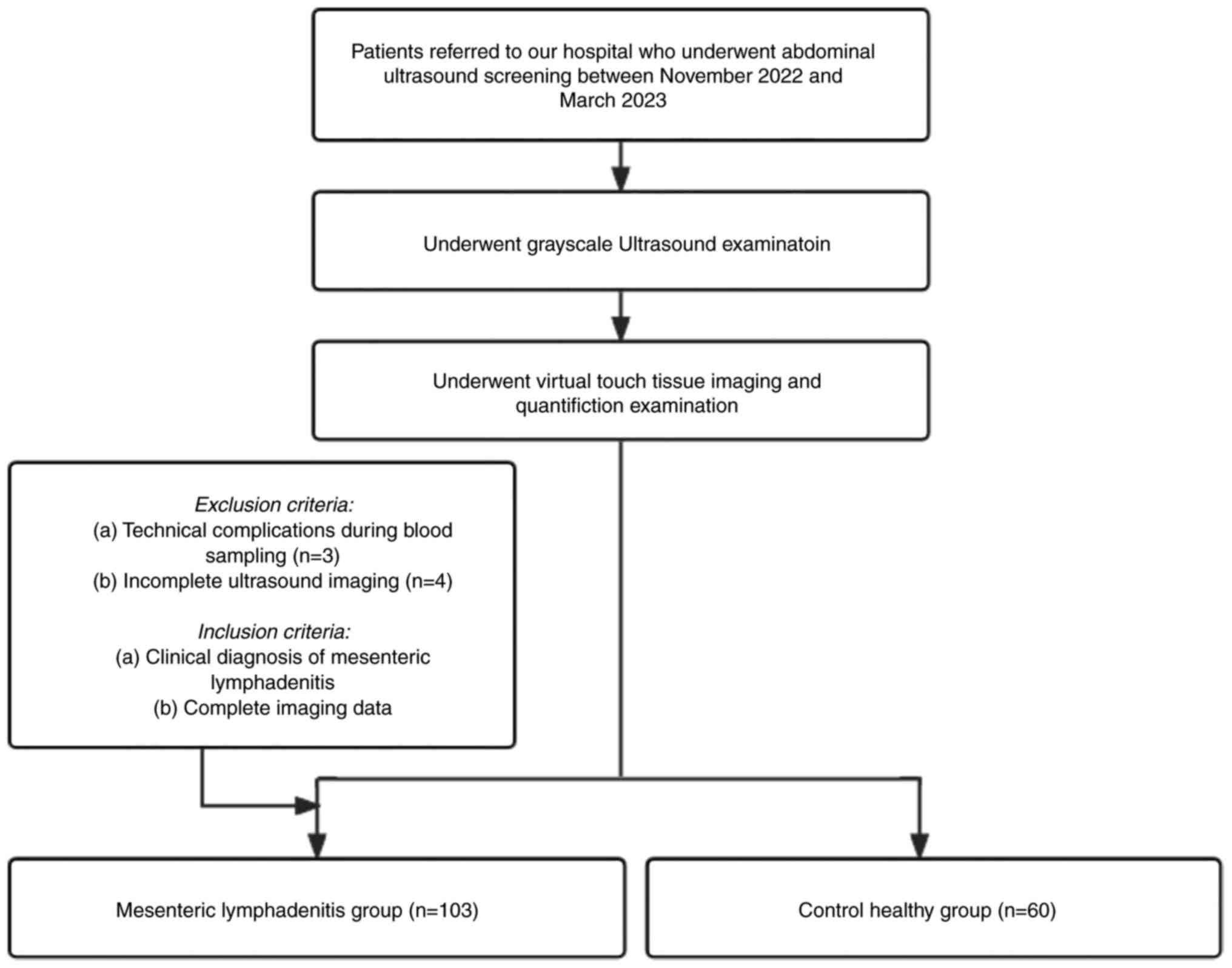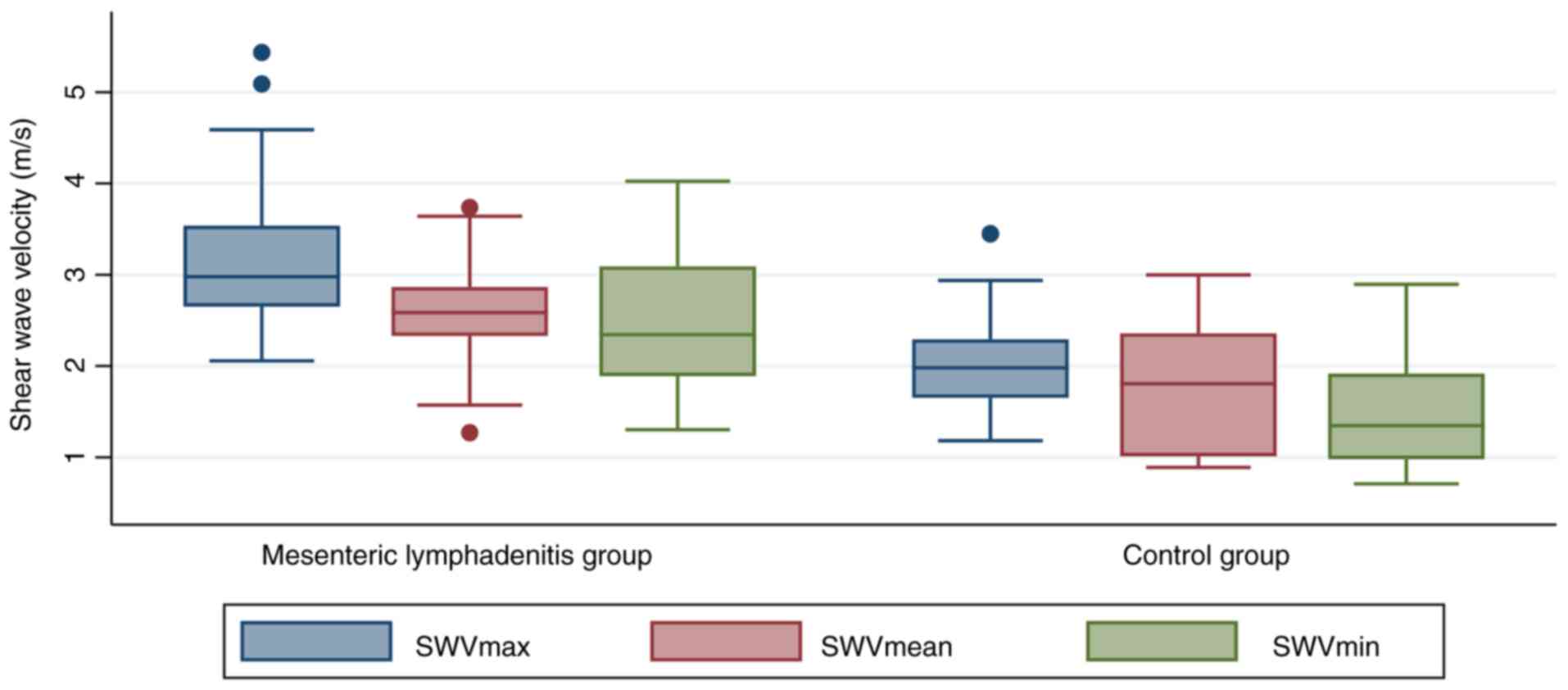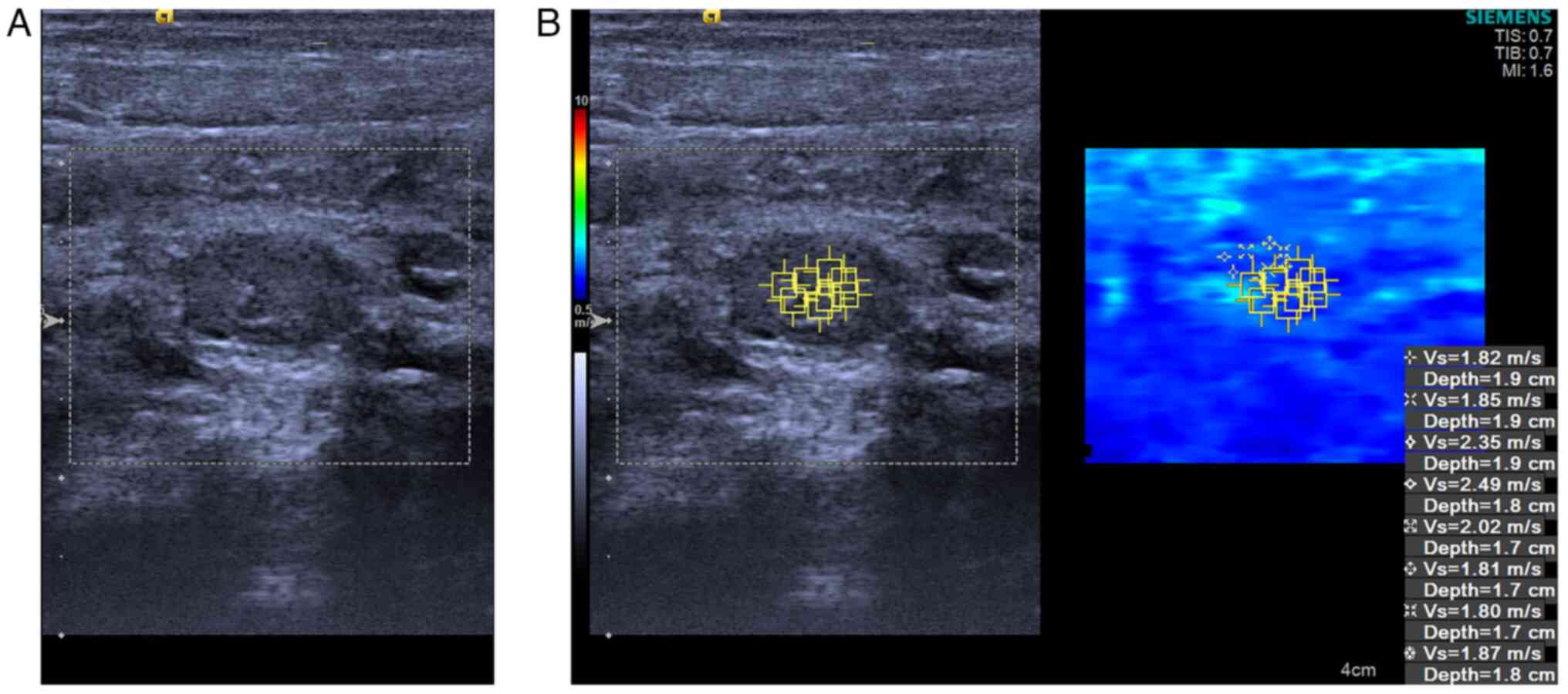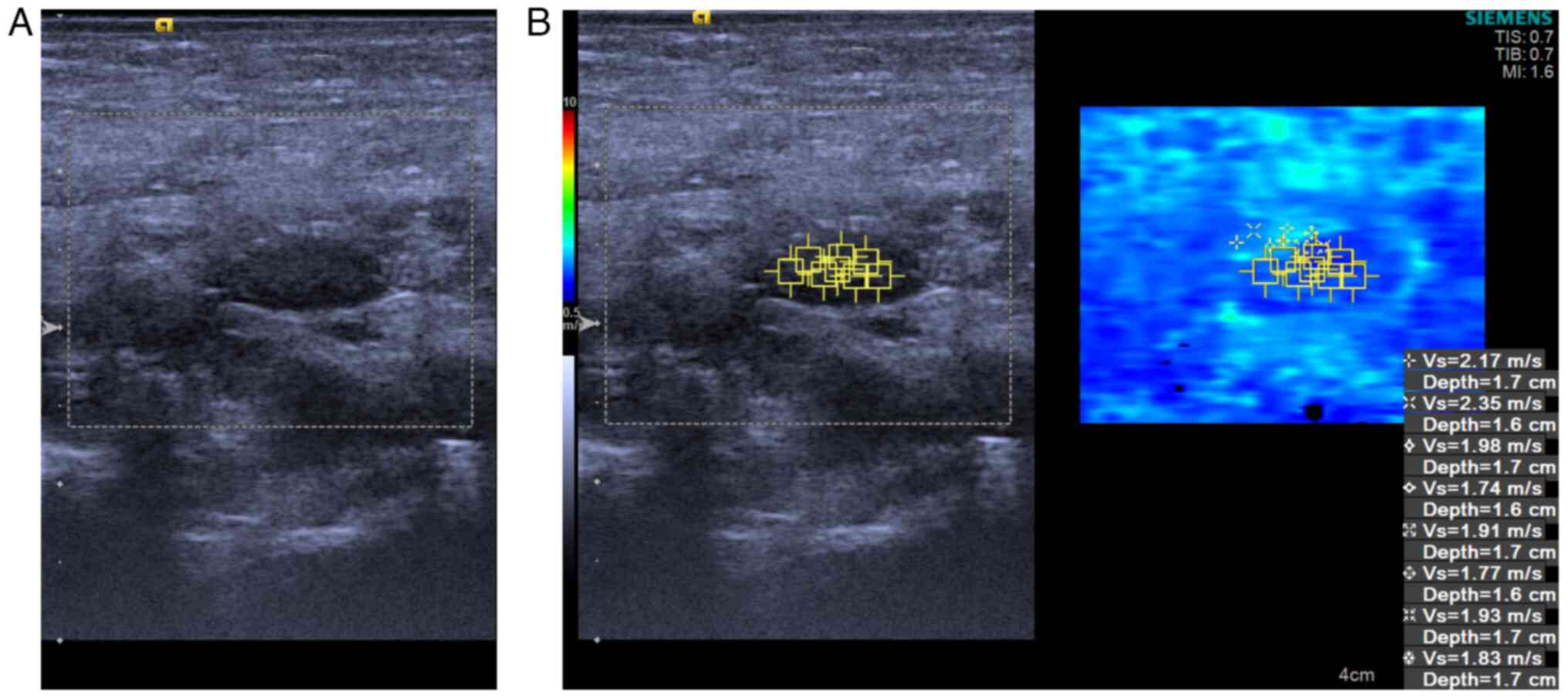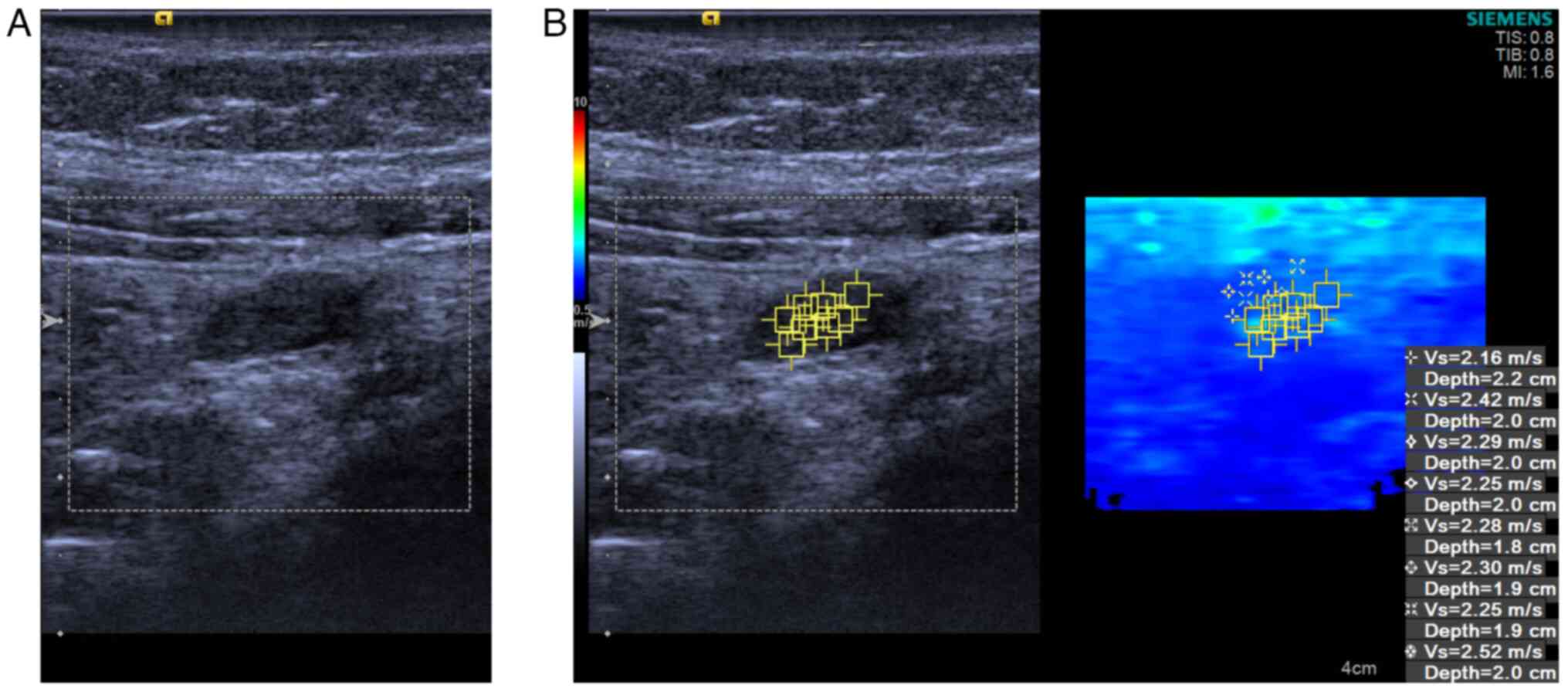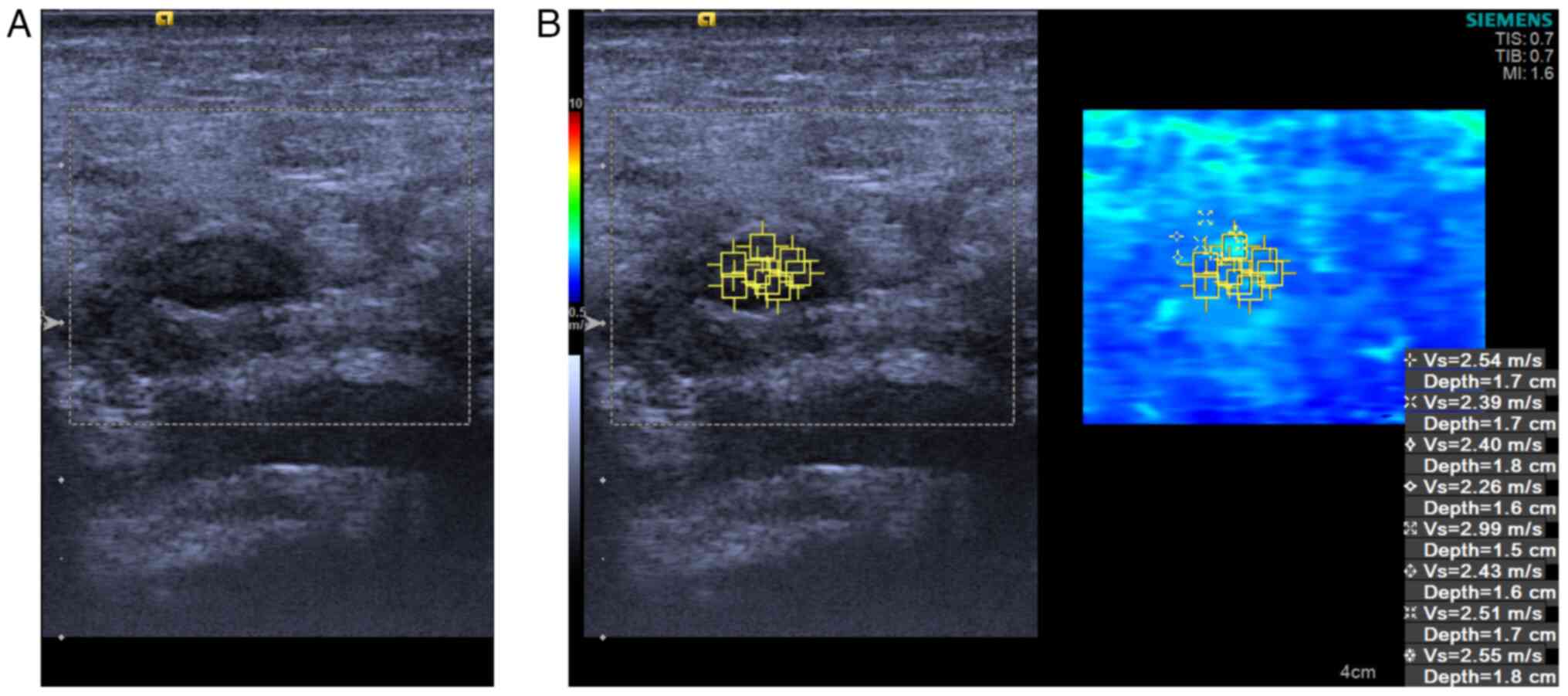Value of conventional ultrasound and shear‑wave elastography in the assessment of mesenteric lymphadenitis in a paediatric population
- Authors:
- Published online on: April 23, 2024 https://doi.org/10.3892/etm.2024.12547
- Article Number: 259
-
Copyright: © Zhou et al. This is an open access article distributed under the terms of Creative Commons Attribution License.
Abstract
Introduction
Mesenteric lymphadenitis (ML) is a benign inflammation of the lymphatic system that is specifically found in the lower quadrant of the abdomen. It presents a distinct inclination for the paediatric and adolescent population, demonstrating a notably greater prevalence among male than female patients (1). Remarkably, this condition shares similarities in terms of abdominal pain presentations with various pathological conditions, including acute appendicitis, intestinal intussusception and constipation (2). Furthermore, analogous to numerous cases of acute abdominal pain, ML often displays mild to moderate elevations in peripheral leukocyte count and C-reactive protein levels.
The diagnosis of ML in young children is challenging due to the absence of distinct clinical manifestations and specific laboratory findings, often leading to the mimicking of other diseases (3). Additionally, it is frequently misreported as the primary cause of pseudoappendicitis (4). Distinguishing ML from other conditions associated with abdominal pain remains a formidable task for paediatric practitioners. This diagnostic ambiguity or inadequate management has the potential to hinder timely identification and intervention, substantially impacting early diagnosis and treatment in affected infants. Hence, there exists a pressing need to actively explore more precise and effective diagnostic approaches to enhance both diagnostic accuracy and therapeutic outcomes in paediatric patients with ML.
Shear-wave elastography (SWE) is an innovative technology commonly used to assess tissue stiffness qualitatively and quantitatively in a variety of tissues and organs, with the liver, breast, and thyroid being the most frequently examined (5-7). Previously, flow through certain organs was assessed using a 2D system to examine changes in blood vessels, determining the flow rate and volume in systole and diastole (8). Changes in blood flow affect tissue stiffness. Elastography techniques, such as Virtual Touch Tissue Imaging and Quantification (VTIQ), can detect alterations in tissue stiffness caused by changes in blood flow. VTIQ provides a 2D image that measures tissue stiffness in a specified region of interest. It offers a precise measurement of shear velocity as it propagates in a direction perpendicular to the detection pulse. By contrast, earlier external pressure elastography methods relied solely on semiquantitative approaches, which depended greatly on the skills of the investigator. Additionally, VTIQ addresses the drawbacks of traditional elastography by providing quantitative data on the structures being examined, such as wave propagation speed values measured in m/sec, presenting them visually on a two-dimensional color-coded map. The substantial diagnostic challenges, such as the condition's resemblance to other abdominal issues, frequently result in misinterpretation, impeding the prompt identification and intervention, highlighting the need for more accurate and effective diagnostic approaches in paediatric patients with ML. Therefore, in the present study, it was aimed to explore the value of conventional ultrasound (US) and VTIQ in the assessment of ML in a paediatric population. The objectives of the present study were to perform non-invasive quantification of MLN stiffness in patients in the ML and control groups; and to investigate the correlation between the diagnostic performance, conventional US and VTIQ characteristics, and laboratory findings.
Materials and methods
Patient enrolment and group allocation
The present retrospective study involved patients who underwent abdominal ultrasound in Pudong New Area People's Hospital affiliated to Shanghai University of Medicine and Health Sciences (Shanghai, China) between November 2022 and March 2023. The inclusion criteria for the ML group required a clinical diagnosis of ML and the provision of complete imaging data. ML was defined as a clinical diagnosis according to the discharge summary found in patients with right lower quadrant pain or tenderness, as well as based on sonographic findings of enlarged MLNs. Enlarged abdominal lymph nodes were specifically identified as those with the shortest diameter of 5 mm (1). Laboratory data, including eosinophil, lymphocyte, monocyte, white blood cell (WBC) and C-reactive protein (CRP) levels, were collected for subsequent analysis. For a comparison, a control group of 60 symptom-free healthy patients was recruited; the aforementioned patients had normal cortical lymph node size, shape and echogenicity along with normal laboratory data. The laboratory data were acquired through a blood test.
The present study was approved (approval no. 2022-K-42; 12 July 2022) by the Shanghai Pudong New Area People's Hospital Ethics Committee (Shanghai, China), and informed consent was waived given the retrospective nature of the study.
Imaging technique and evaluation
All MLNs in both the ML and control groups underwent grayscale US and VTIQ examinations. The US assessments in both groups began with an initial abdominal examination using a Toshiba Aplio 500 (Canon Medical Systems Corporation), which was equipped with a 14 MHz line array transducer. This examination included transverse and longitudinal scans of the lower abdominal area for each patient. Conventional US characteristics such as dimensions and shapes were recorded. Dimensions included the longest diameter (cm) and the relative proportions of the longest and shortest diameter, represented by the longest diameter/shortest diameter ratio.
Afterwards, VTIQ examinations were performed using a Siemens Oxana2 machine (Siemens Medical Solutions USA, Inc.) equipped with a 9 MHz frequency 9L4 linear transducer. To ensure consistency, the same operator conducted all US and VTIQ examinations, and patients were requested to maintain the same position throughout both tests. Shear-wave velocity (SWV) values were quantified using a strategically placed 2x2 mm region of interest (ROI). Notably, SWV measurements were rigorously obtained on eight occasions for each MLN under scrutiny. When the MLNs exhibited a uniform stiffness distribution, eight ROI boxes were randomly placed by the operator. In cases where the MLN displayed varying degrees of stiffness distribution, a meticulous approach was taken. Based on the color scale of the velocity map, the ROIs were positioned from the area with the highest SWV to the one with the lowest SWV, encompassing the stiffest and softest regions, each represented by one area. The study derived three distinct SWV values: SWVMean, SWVMax and SWVMin.
Statistical analysis
Continuous variables were analysed through independent unpaired t-tests or Mann-Whitney U tests, while categorical variables were compared using the Chi-squared (X2) test or Fisher's exact test. SWV values were compared between those with ML and healthy individuals using the Wilcoxon rank-sum test. Pearson or Spearman bivariate correlation analyses was performed to examine the associations between clinical parameters and the stiffness of the largest MLN. Multivariate logistic regression analysis was utilized to determine the impact of various clinical factors on MLN stiffness. Receiver operating characteristic (ROC) curves were generated to evaluate the diagnostic performance of US alone and US + VTIQ, with clinical confirmation (including clinical symptoms, laboratory results and imaging information) by a paediatrician serving as the gold standard. Statistically significant difference was considered when the P<0.05. The statistical analysis was conducted using SPSS 24.0 software (IBM Corp.) and Stata 15.0 software (StataCorp LP).
Results
Baseline characteristics
In the present study, 103 patients who were diagnosed with ML and 60 healthy individuals were included (Fig. 1). Notably, there were no significant differences in age or sex distribution between the two groups (both P>0.05) (Table I). The median age of the individuals in the control cohort was 6.02±1.52 years (range, 3-9 years) and that of the individuals in the reference cohort was 6.24±1.40 years (range, 4-9 years). In children afflicted with ML, common clinical manifestations included a body temperature of 37.90±0.80˚C, nausea (77.67%) and anorexia (50.49%).
Table IDemographic and clinical parameters of children with mesenteric lymphadenitis and children in the control group. |
In children with ML, a total of 292 MLNs were identified, with a median patient count of 2.83±1.00. Conversely, in the cohort of healthy controls, 167 MLNs were detected, with a median count of 2.78±1.12 (Table I). It is noteworthy, however, that no significant disparity in the observed number of MLNs was detected between the two cohorts (P=0.762). Within the ML group, 71.92% (210/292) of the MLNs were enlarged (Table II). Conversely, in the control cohort, 66.47% (111/167) of the MLNs exhibited enlargement. The 210 enlarged MLNs in children with ML were located in the right lower quadrant. In the left lower quadrant, 8 healthy children displayed 19 out of 111 enlarged MLNs. The dimensions of MLNs in children with ML outstripped those in the control cohort. In children with ML, the longest diameter (1.29±0.31 cm vs. 1.08±0.21 cm) of the MLNs was significantly greater than that in the healthy cohort (P<0.001).
Laboratory findings
Compared with those in the control cohort (all P<0.001), the WBC (11.09±3.41x109/l vs. 8.83±1.56x109/l), CRP level (8.22±1.85 mg/dl vs. 5.40±1.50 mg/dl), eosinophil (2.07±1.16% vs. 0.21±0.07), lymphocyte (24.46±10.51% vs. 6.01±1.56) and monocyte (7.90±3.03% vs. 0.50±0.08) counts in children with ML were significantly increased (Table I).
Stiffness observations
All the quantitative VTIQ parameters (including the SWVMean, SWVMax and SWVMin) were significantly greater for MLNs in the control group than for MLNs in the ML group (Fig. 2) (all P<0.001). The SWV in the control group was nearly 2-fold greater than that in the ML group (Table III). Consequently, patients afflicted in ML (Figs. 3 and 4) demonstrated stiffer MLNs in comparison with those in the healthy group (Figs. 5 and 6).
Univariate and multivariate logistic analyses
The results of univariate logistic regression analysis are summarized in Table IV. Binary logistic regression analysis revealed that monocytes ≥7.90% [odds ratio (OR)=63.078; P=0.038], longest diameter ≥1.29 cm (OR=18.123, P<0.001), and CRP≥8.22 mg/dl (OR=2.501; P<0.001) were independent factors related to ML. In addition, the VTIQ parameter (SWVMean ≥1.81 m/s; OR=0.106; P<0.001) was also significantly correlated with ML. According to the multivariate logistic regression analysis, the longest diameter (OR=6.042; P=0.046) was revealed to be the strongest independent predictor for ML, followed by the CRP level (OR=2.310; P<0.001) and the SWVMean (OR=0.108; P<0.001) (Table IV).
Diagnostic performance of conventional US and US elastography
According to the ROC analyses, the associated AUC for US alone was 0.798 (95% CI: 0.724-0.872), with a sensitivity of 79.61% and a specificity of 80.00% (Table V). The AUC for US combined with VTIQ was 0.890 (95% CI: 0.831-0.949), with a high sensitivity of 91.26% and a high specificity of 86.67%. Both methods were assessed by taking laboratory findings into consideration.
Discussion
VTIQ, a two-dimensional quantitative SWV imaging technique based on ARFI technology, employs a pulse sequence encompassing reference, excitation and tracking sonic pulses. Compared with conventional point SWV measurements, the 2D SWV imaging provided by VTIQ offers more precise information regarding tissue stiffness (7). Quantitative reflection of nodular hardness is achieved by VTIQ through multiple measurements conducted in a clear quality mode with minimal interference. Different color levels indicate quality, with a transition to the speed mode indicating favorable quality. This quantitative representation of tissue hardness enhances the reliability of the measurements. In recent years, VTIQ has gained traction in diverse clinical applications across organs, including the thyroid (9), breast (10) and cervical lymph nodes (11). However, the assessment of MLN stiffness, a potential indicator of ML, has scarcely been explored. In a research study involving 263 paediatric MLNs, Bayramoglu et al (12) reported that the median elasticity and velocity values obtained through SWE were markedly greater in patients with lymphoma than in those with lymphadenitis and normal MLNs. However, the present study yielded contrasting results; it represents a pioneering effort to quantitatively and non-invasively evaluate MLN stiffness in patients with ML compared with a healthy group. Remarkably, compared with those in the reference group, the ML group exhibited a significant increase in the mean, maximum and minimum SWV. ML is a condition characterized by inflammation of the lymph nodes in the mesentery. Cells involved in inflammation, and found in lymph nodes, and the mediators and cytokines produced by these cells play important roles in defense against infection (13,14). Tissue stiffness is a characteristic that may reflect the nature of lymph nodes (15). It is conceivable that a majority of MLNs in the ML group may be in an acute inflammatory edema phase, rendering them appear soft and relatively less dense in structure, thereby resulting in lower SWV values than those of normal MLN tissue. Similar findings were observed in head and neck lymph nodes, with a greater emphasis on distinguishing between benign and malignant lymph nodes (16-18).
VTIQ, when combined with conventional US, exhibited enhanced sensitivity in the identification of ML, with a sensitivity of 91.26% for the mean SWV and heightened specificity of 86.67%, compared with the use of conventional US alone. The AUC for US combined with VTIQ was greater (AUC: 0.890; 95% CI: 0.831-0.949) than that for the standalone US method (AUC: 0.798; 95% CI: 0.724-0.872), supporting the conclusion that combining US with VTIQ enhances the diagnostic accuracy and effectiveness of detecting ML. ML often mimics the clinical presentations of acute appendicitis, intussusception, ovarian torsion and other acute abdominal conditions (19,20). The accurate identification of ML is of utmost importance. With the help of VTIQ, the false-negative rate decreased from 20.39% (21/103) to 8.74% (9/103), while the accuracy rate significantly improved from 79.75% (130/163) to 89.57% (146/163) when considering both US and VTIQ characteristics.
Neither US nor VTIQ parameters in isolation could substantially contribute to ML identification. Binary logistic regression analysis revealed that a monocyte count ≥7.90% (OR=63.078; P=0.038), longest diameter ≥1.29 cm (OR=18.123; P<0.001), and CRP level ≥8.22 mg/dl (OR=2.501; P<0.001) were independent factors associated with ML. Among the 103 ML patients, 47 exhibited an elevated monocyte percentage (≥7.90%), while patients in the reference group maintained a normal monocyte percentage. Furthermore, 58 out of 103 ML patients demonstrated elevated CRP levels (≥8.22 mg/dl), whereas only 6 out of 60 healthy patients had elevated CRP levels. These findings aligned with those of Gross et al (21), where ML patients exhibited a median CRP level of 0.475 (range, 0-19.3 mg%) and a monocyte percentage of 7.64±3.41.
Traditionally, the diagnosis of lymph node abnormalities relies on size criteria (2). However, these size criteria vary among different scholars, with some considering MLNs with the longest diameters exceeding 10 mm to be pathologically enlarged (22), while others defined enlarged lymph nodes as those with the shortest diameter of 4 mm or greater (23). In the present study, the longest diameter of the enlarged MLNs in the ML group was 1.29±0.31 cm, whereas in the reference group, it was 1.08±0.21 cm. However, in clinical practice, size measurements alone are not sufficient for assessing whether an MLN is pathological. According to the present multivariate analysis, the longest diameter of the enlarged MLN significantly contributed to the identification of ML, followed by the CRP and the VTIQ parameters (SWVMean ≥1.81 m/s, OR=0.106, P<0.001). In terms of diagnostic performance, the integration of VTIQ with US substantially enhanced the sensitivity (91.26% vs. 79.61%), specificity (86.67% vs. 80.00%), and accuracy (89.57% vs. 79.75%) in contrast to the use of US in isolation. The false-negative rate decreased significantly from 20.39% (21/103) to 8.74% (9/103).
Given the retrospective design and the relatively modest sample size inherent to this single-centre investigation, it is imperative to interpret the current findings as preliminary, necessitating validation through expansive multicentre studies. Furthermore, the VTIQ examinations in the present study were conducted by only one operator. This implies that for future research, it is essential to engage multiple operators to assess inter- and intra-observer reliability.
In conclusion, the use of VTIQ to assess mesenteric lymph node (MLN) stiffness offers a non-invasive, convenient, reliable and reproducible approach for identifying mesenteric lymphadenopathy. A significant positive correlation between increased VTIQ parameters and ML was observed. Although this approach shows promise for the evaluation of MLN stiffness in patients with ML, its full potential and clinical utility necessitate further comprehensive investigation.
Acknowledgements
Not applicable.
Funding
Funding: The present study was supported by the General Project Grant from the Pudong Health Commission of Shanghai (grant no. PW2022A-05) and the National Natural Science Foundation of China (grant no. 82302231).
Availability of data and materials
The data generated in the present study may be requested from the corresponding author.
Authors' contributions
YCZ designed the study. LZ and JS collected and analysed the patients' data regarding tissue stiffness. DMZ collected and analysed the patients' laboratory and clinical diagnosis data. YZ, QJ, XRS and SHD interpreted the data. LZ and JS were major contributors to the writing of the manuscript. YCZ and QJ confirm the authenticity of all the raw data. All authors have read and approved the final manuscript.
Ethics approval and consent to participate
The present study was approved (approval no. 2022-K-42; 12 July 2022) by the Ethics Committee of Shanghai Pudong New Area People's Hospital (Shanghai, China). Informed consent was waived due to the retrospective nature of the study.
Patient consent for publication
Not applicable.
Competing interests
The authors declare that they have no competing interests.
References
|
Devine M and Coffey JC: Mesenteric Adenopathy and Adenitis. Prog Inflammation Res. 90:127–148. 2023. | |
|
Simanovsky N and Hiller N: Importance of sonographic detection of enlarged abdominal lymph nodes in children. J Ultrasound Med. 26:581–584. 2007.PubMed/NCBI View Article : Google Scholar | |
|
Toorenvliet B, Vellekoop A, Bakker R, Wiersma F, Mertens B, Merkus J, Breslau P and Hamming J: Clinical differentiation between acute appendicitis and acute mesenteric lymphadenitis in children. Eur J Pediatr Surg. 21:120–123. 2011.PubMed/NCBI View Article : Google Scholar | |
|
Ozdamar MY and Karavas E: Acute mesenteric lymphadenitis in children: Findings related to differential diagnosis and hospitalization. Arch Med Sci. 16:313–320. 2018.PubMed/NCBI View Article : Google Scholar | |
|
Evans A, Whelehan P, Thomson K, McLean D, Brauer K, Purdie C, Baker L, Jordan L, Rauchhaus P and Thompson A: Invasive breast cancer: Relationship between shear-wave elastographic findings and histologic prognostic factors. Radiology. 263:673–677. 2012.PubMed/NCBI View Article : Google Scholar | |
|
Wong VW, Vergniol J, Wong GL, Foucher J, Chan HL, Le Bail B, Choi PC, Kowo M, Chan AW, Merrouche W, et al: Diagnosis of fibrosis and cirrhosis using liver stiffness measurement in nonalcoholic fatty liver disease. Hepatology. 51:454–462. 2010.PubMed/NCBI View Article : Google Scholar | |
|
Sun CY, Lei KR, Liu BJ, Bo XW, Li XL, He YP, Wang D, Ren WW, Zhao CK and Xu HX: Virtual touch tissue imaging and quantification (VTIQ) in the evaluation of thyroid nodules: The associated factors leading to misdiagnosis. Sci Rep. 7(41958)2017.PubMed/NCBI View Article : Google Scholar | |
|
Glišić TM, Perišić MD, Dimitrijevic S and Jurišić V: Doppler assessment of splanchnic arterial flow in patients with liver cirrhosis: Correlation with ammonia plasma levels and MELD score. J Clin Ultrasound. 42:264–269. 2014.PubMed/NCBI View Article : Google Scholar | |
|
Zhou H, Zhou XL, Xu HX, Li DD, Liu BJ, Zhang YF, Xu JM, Bo XW, Li XL, Guo LH and Qu S: Virtual touch tissue imaging and quantification in the evaluation of thyroid nodules. J Ultrasound Med. 36:251–260. 2017.PubMed/NCBI View Article : Google Scholar | |
|
Kong WT, Zhou WJ, Wang Y, Zhuang XM and Wu M: The value of virtual touch tissue imaging quantification in the differential diagnosis between benign and malignant breast lesions. J Med Ultrason (2001). 46:459–466. 2019.PubMed/NCBI View Article : Google Scholar | |
|
Ruger H, Psychogios G, Jering M and Zenk J: Multimodal ultrasound including virtual touch imaging quantification for differentiating cervical lymph nodes. Ultrasound Med Biol. 46:2677–2682. 2020.PubMed/NCBI View Article : Google Scholar | |
|
Bayramoglu Z, Caliskan E, Karakas Z, Karaman S, Tugcu D, Somer A, Acar M, Akıcı F and Adaletli I: Diagnostic performances of superb microvascular imaging, shear wave elastography and shape index in pediatric lymph nodes categorization: A comparative study. Br J Radiol. 91(20180129)2018.PubMed/NCBI View Article : Google Scholar | |
|
Jurisic V, Terzic T, Colic S and Jurisic M: The concentration of TNF-alpha correlate with number of inflammatory cells and degree of vascularization in radicular cysts. Oral Dis. 14:600–605. 2008.PubMed/NCBI View Article : Google Scholar | |
|
Dzopalić T, Božić-Nedeljković B and Jurišić V: Function of innate lymphoid cells in the immune-related disorders. Hum Cell. 32:231–239. 2019.PubMed/NCBI View Article : Google Scholar | |
|
Handorf AM, Zhou Y, Halanski MA and Li WJ: Tissue stiffness dictates development, homeostasis, and disease progression. Organogenesis. 11:1–15. 2015.PubMed/NCBI View Article : Google Scholar | |
|
Desmots F, Fakhry N, Mancini J, Reyre A, Vidal V, Jacquier A, Santini L, Moulin G and Varoquaux A: Shear wave elastography in head and neck lymph node assessment: Image quality and diagnostic impact compared with B-Mode and doppler ultrasonography. Ultrasound Med Biol. 42:387–398. 2016.PubMed/NCBI View Article : Google Scholar | |
|
Yang JR, Song Y, Jia YL and Ruan LT: Application of multimodal ultrasonography for differentiating benign and malignant cervical lymphadenopathy. Jpn J Radiol. 39:938–945. 2021.PubMed/NCBI View Article : Google Scholar | |
|
Dudea SM, Botar-Jid C, Dumitriu D, Vasilescu D, Manole S and Lenghel ML: Differentiating benign from malignant superficial lymph nodes with sonoelastography. Med Ultrason. 15:132–139. 2013.PubMed/NCBI View Article : Google Scholar | |
|
Grossman M and Shiramizu B: Evaluation of lymphadenopathy in children. Curr Opin Pediatr. 6:68–76. 1994.PubMed/NCBI View Article : Google Scholar | |
|
Lau WY, Fan ST, Yiu TF, Chu KW and Wong SH: Negative findings at appendectomy. Am J Surg. 148:375–378. 1984.PubMed/NCBI View Article : Google Scholar | |
|
Gross I, Siedner-Weintraub Y, Stibbe S, Rekhtman D, Weiss D, Simanovsky N, Arbell D and Hashavya S: Characteristics of mesenteric lymphadenitis in comparison with those of acute appendicitis in children. Eur J Pediatr. 176:199–205. 2017.PubMed/NCBI View Article : Google Scholar | |
|
Schulte B, Beyer D, Kaiser C, Horsch S and Wiater A: Ultrasonography in suspected acute appendicitis in childhood-report of 1285 cases. Eur J Ultrasound. 8:177–182. 1998.PubMed/NCBI View Article : Google Scholar | |
|
Sivit CJ, Newman KD and Chandra RS: Visualization of enlarged mesenteric lymph nodes at US examination. Clinical significance. Pediatr Radiol. 23:471–475. 1993.PubMed/NCBI View Article : Google Scholar |



